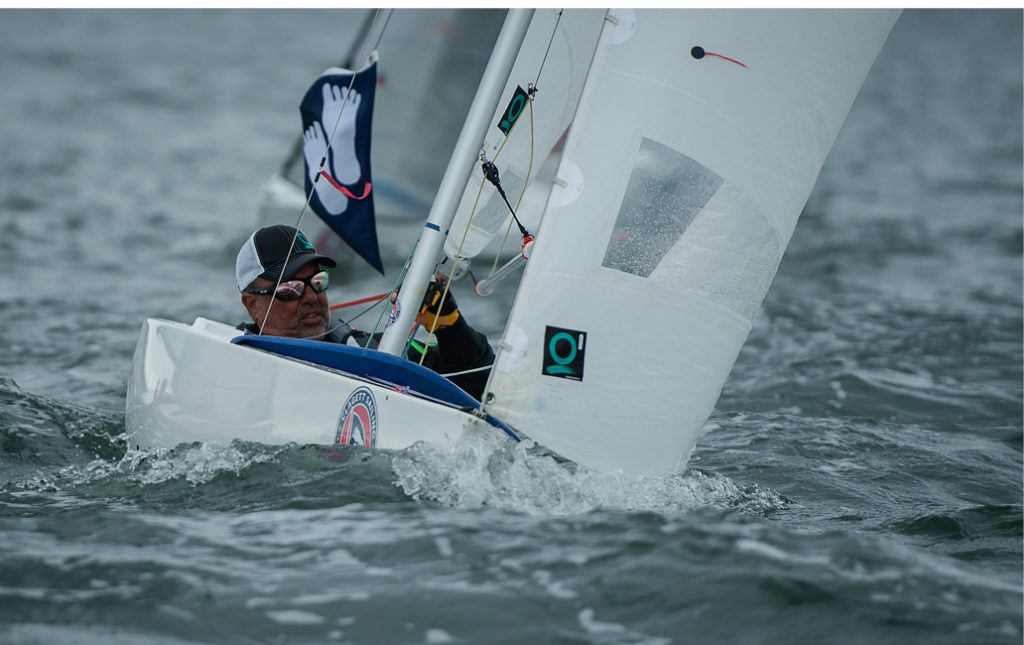Editor’s note: Part 1 of Dave’s article can be found here.
Luff tension Like the mainsail cunningham, the jib halyard is not intended primarily for removing wrinkles so the sail looks better. The main purpose of the halyard is to adjust luff tension and thereby control the position of draft in the sail. Pull the halyard tighter to move draft forward and make the sail flatter; ease it to move the draft aft and make the sail fuller.
Speed wrinkles Sometimes the presence (or absence) of wrinkles along the luff of the sail is a helpful guide for getting the right halyard tension. In light air, it’s good to see anywhere from a hint to a multitude of wrinkles (except for laminated sails where you usually tension the halyard just enough to remove wrinkles). In heavy air, you usually need enough luff tension to remove all of the wrinkles.
Fore-and-aft lead Set the fore-and-aft position of the jib lead so the telltales on the windward side lift (stall) more or less simultaneously up and down the luff. In many cases, the top (windward) telltale will fly a little earlier than the others. This is OK, especially in light or heavy wind. However, if it breaks a lot earlier, then move the lead forward. If it breaks later, you should definitely move the lead aft.
In-and-out lead On many boats, you also have the option to move your leads inboard or outboard. A rule of thumb here is to move the lead as far inboard as possible without hurting the main- sail or slowing the boat. You want the lead farthest inboard in flat water and moderate wind; it will usually have to go farther outboard in light air, heavy air and chop.

A member of the 2025 Team Clagett, Julio Reguero (San Juan, PR) will be representing Clagett Sailing at the 2.4mR World Championships in Lake Garda, Italy in October. © Clagett Sailing/Andes Visual
Headstay sag The primary way to fine-tune the amount of power in your headsail is by adjusting headstay sag. Use your backstay (or running backstay) to increase or decrease sag and the overall fullness of the jib.
The harder you pull the backstay, the less headstay sag you’ll have and the flatter your sail will be. A straighter headstay also moves the draft aft in the headsail, just as bending the mast does in the main.
Barberhauling On some boats, the existing jib leads are too far outboard, so you need to “barberhaul” the clew inboard by using the windward jib sheet (on one-designs) or a jib in-hauler (bigger boats). If the boat gets overpowered and you have to ease the mainsheet or traveler a lot, you may need to barberhaul outboard to keep the slot between the mainsail and jib from getting too closed.
Asymmetries The jib should normally be trimmed the same on each tack, but watch out for times when you have wind sheer or waves that aren’t aligned with the wind. In these conditions, you will probably have to vary lead position and sheet tension from tack to tack.
Shift gears Like the mainsail, the jib needs constant adjustment because wind and wave conditions are always changing. When the boat feels good, try sneaking the jib sheet in another inch. If you’re slow or in doubt, let it out. Remember, the jib should work closely in concert with the main in order to have the best performance.
Keep track If you have a little time, it’s helpful to keep a written record of everything you learn about your jib or genoa. Here are two ways to do this: 1) If you use just one jib design, make notes after each day of sailing. Record the wind and sea conditions, the settings you used and a note about your performance; 2) If you use two or more jib designs, organize your notebook by sail. For each jib, keep track of its wind range, hours used and optimal settings (lead, halyard, etc.) in various conditions. ■
This article originally appeared in David Dellenbaugh’s Speed & Smarts, The newsletter of how-to tips for racing sailors. If you want to sail faster and smarter, log onto SpeedandSmarts.com.




